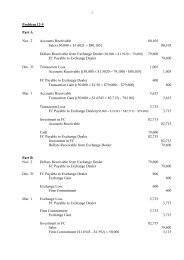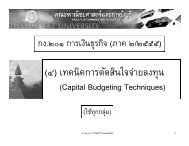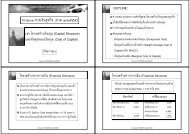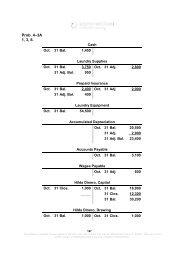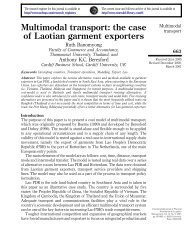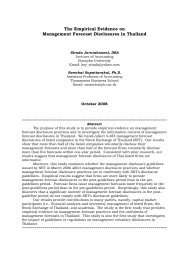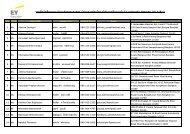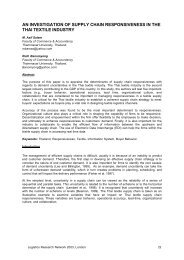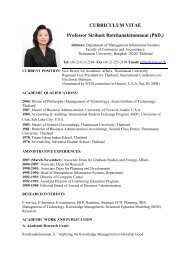Human capital and performance: A literature review
Human capital and performance: A literature review
Human capital and performance: A literature review
Create successful ePaper yourself
Turn your PDF publications into a flip-book with our unique Google optimized e-Paper software.
action. Also, it provides a basis to analyze <strong>and</strong> to critique employment practices by asking a set of<br />
questions that relate to the reasons that organization exist <strong>and</strong> the value (norms, trust, <strong>and</strong> relationship)<br />
that individuals place in their membership, leading to their contributions to the organization.<br />
McElroy, M. W. (2002). Social innovation <strong>capital</strong>. Journal of Intellectual Capital, 3 (1), pp. 30-39.<br />
The author introduces the notion of ‘social innovation <strong>capital</strong>’ (SIC), the capacity of a firm to<br />
innovate, as the most valuable form of intellectual <strong>capital</strong> because it underlies a firm’s fundamental<br />
capacity to learn, innovate, adapt <strong>and</strong> enhance the <strong>performance</strong>. The modified intellectual <strong>capital</strong> map<br />
with social <strong>capital</strong> thread added <strong>and</strong> customer <strong>capital</strong> repositioned has been proposed on the ground of<br />
the argument against Sk<strong>and</strong>ia’s model developed by Edvinsson. The SIC model engages the whole<br />
firm in the learning <strong>and</strong> innovation process, not simply stop at the borders of the R&D function, or wit<br />
the ranks of senior management. Its implication surrounds the idea of building the innovation climate<br />
within the firm where management policies of innovation (e.g. learning, knowledge processing,<br />
connected ness, <strong>and</strong> ethodiversity) are put in place.<br />
Nahapiet, J. & Ghoshal, S. (1997). Social <strong>capital</strong>, intellectual <strong>capital</strong> <strong>and</strong> the creation of value in<br />
firms. Academy of Management Proceedings, pp. 35-39.<br />
The authors make theoretical propositions in identifying the creation of the value in firms through the<br />
existence of social <strong>capital</strong>, <strong>and</strong> the amount , forms <strong>and</strong> configuration of this <strong>capital</strong> available to the<br />
firm, which underpin its potential for developing the intellectual <strong>capital</strong>.<br />
Nahapiet, J. & Ghoshal, S. (1998). Social <strong>capital</strong>, intellectual <strong>capital</strong>, <strong>and</strong> the organizational<br />
advantage. Academy of Management Review, 23 (2), pp. 242-266.<br />
The focus of the paper is to link between social <strong>and</strong> intellectual <strong>capital</strong> in order to enhance the<br />
organizational advantage. The authors develop three main arguments: (1) social <strong>capital</strong> facilitates the<br />
creation of new intellectual <strong>capital</strong>; (2) organizations, as institutional settings, are conducive to the<br />
development of high levels of social <strong>capital</strong>; <strong>and</strong> (3) it is because of their more dense social <strong>capital</strong> that<br />
firms, within certain limits, have an advantage over markets in creating <strong>and</strong> sharing intellectual <strong>capital</strong>.<br />
Intellectual Capital – A Competence of <strong>Human</strong> Capital<br />
Bontis, N. (1998). Intellectual <strong>capital</strong>: an exploratory study that develops measures <strong>and</strong> models.<br />
Management Decision, 36 (2), pp. 63-76.<br />
The research aims to explore the ideas <strong>and</strong> concepts of various conceptual measures/models with<br />
regard to intellectual <strong>capital</strong> <strong>and</strong> its impact on business <strong>performance</strong>. The result supports the author’s<br />
postulation that the link between dimensions of intellectual <strong>capital</strong> (i.e. structural, human, <strong>and</strong><br />
customer <strong>capital</strong>) <strong>and</strong> business <strong>performance</strong> is positive <strong>and</strong> substantive. The author asserts that<br />
examining the processes underlying intellectual <strong>capital</strong> development may be of more importance than<br />
ever finding out what is all worth in monetary terms. Also, all business managers should underst<strong>and</strong><br />
the power of knowledge management on business <strong>performance</strong> <strong>and</strong> how intellectual <strong>capital</strong> can<br />
contribute to the firm’s success. This requires people in the organization to rethink their attitudes<br />
toward intangible assets <strong>and</strong> to start recognizing that measuring <strong>and</strong> strategically managing knowledge<br />
may make the difference between mediocrity <strong>and</strong> excellence.<br />
Bontis, N. (2001). Assessing knowledge assets: a <strong>review</strong> of the models used to measure<br />
intellectual <strong>capital</strong>. International Journal of Management Reviews, 3 (1) March, pp. 41-60.<br />
This paper <strong>review</strong>s the <strong>literature</strong> pertaining to the assessment of knowledge assets. It summarizes the<br />
current models being utilized in intellectual <strong>capital</strong> assessment circles. Also, their conceptualizations<br />
<strong>Human</strong> <strong>capital</strong> <strong>and</strong> <strong>performance</strong> 37



